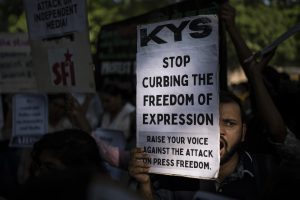In June, India expelled a New Delhi-based French reporter, Sébastien Farcis, after refusing to renew his work permit. Farcis had been based in India since 2011, holding permanent resident status — also called the Overseas Citizen of India (OCI) card — in the country. But he was given no explanation by Indian authorities for their decision not to renew his work permit as a journalist.
Farcis is only the latest in a flurry of cases this year involving the abrupt expulsion of foreign journalists based in India. In February, another French reporter with OCI status, Vanessa Dougnac, also lost her work permit. Dougnac had been based in India for over two decades with her family. In April, an Australian reporter, Avani Dias, left in similarly chaotic circumstances after being refused an extension of her work permit. Dias was given a temporary visa extension at the last minute following lobbying by the Australian government but decided to fly out anyway.
For the most part, Prime Minister Narendra Modi’s silent crackdown on foreign journalists has gone unnoticed. Yet it has significant implications for India and the world.
India had long been unusually welcoming to foreign journalists, giving them access even to sensitive regions such as Kashmir. But under Modi, the battle lines have expanded significantly and are often unclear.
In some cases, the message comes loud and clear. In the run-up to her departure, for instance, the Australian reporter Dias said that Indian authorities had complained about her coverage of Canada’s accusations that India was responsible for the killing of a Sikh separatist in that country. But most foreign journalists are given no clear explanation of their “crimes,” and the costs are steep: upending their lives, livelihoods, and families in India. Farcis, for instance, had lived in India for years and married an Indian wife.
The implications of these developments go beyond the personal and professional lives of the journalists themselves. For decades, even as India’s relations with the West waxed and waned, foreign reporters often played the role of demystifying India for the West — helping build goodwill for India’s democracy, culture, and people even as China and Russia remained opaque black boxes. That role didn’t just make India more relatable and palatable to the West, it also kept the West informed about India and its worldview even as ties between India and the West atrophied.
The links created by a vigorous foreign media presence in India also prevented the two sides from succumbing to unrealistic expectations in the relationship and encouraged the West to accommodate and welcome India’s rise. In India, the West saw an environment of debate, dissension, and discourse that it could relate to and embrace, because its own journalists were allowed to report freely and critically in the country. That was the opposite of what happened in China and Russia; foreign journalists in those two countries frequently faced threats and their troubles were often reported back to audiences in the West, provoking backlash.
The advent of Modi and Hindu nationalism has tested India’s congenial compact with the foreign press. Modi and his party, the Bharatiya Janata Party (BJP), have long believed that Western journalists are unsympathetic to their brand of religious nationalism and their attitude toward minority rights. To address that complaint, Modi has overseen a flurry of restrictions and intimidatory tactics against foreign journalists.
But these restrictions will also mean that an important channel of dialogue and exchange between India and the West is closing rapidly. It will also mean that the West has fewer reliable means through which to understand ground realities in India — making ties with India liable to the same miscalculations that have plagued dealings with China and Russia over the years.
Tensions over Sikh separatism or the presence of Indian dissidents in the West will also increasingly put foreign journalists at risk. The case of Dias is particularly instructive in that context: Dias claims that her visa problems began because of a documentary on Sikh separatism and Hardeep Singh Nijjar — the separatist leader in whose murder Canada has implicated the Indian government. Foreign journalists are unlikely to avoid these stories, given their direct relevance to audiences in the West. And if New Delhi sees foreign reporters as agents of the West for their reporting on the topic, it might target them far more aggressively.
So far, both Indian and Western policymakers have ignored the side-effects of New Delhi’s ongoing war with the foreign press. But these developments have the potential to cause problems for the relationship.

































